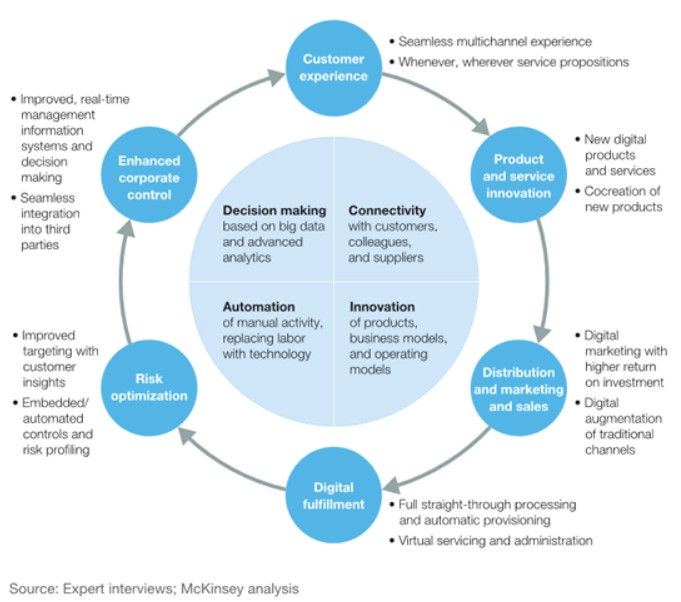What is Digital Transformation?
Digital technologies, and the ways we use them in our personal lives, work and society, have changed the face of business and will continue to do so. This has always been the case, but the pace at which it is happening is accelerating and faster than the pace that traditionally structured organisations can cope with. The development of new competencies through successful digital transformation, with some examples in this blog, revolves around organisational capacities to be more agile, people-oriented, innovative, customer-centric, streamlined and efficient. Plus, the ability to induce/leverage opportunities to change the status quo and tap into the otherwise overwhelming amount of big data. There are also new and increasingly unstructured data sources, and service-driven revenues.
Why is Digital Transformation important?
A survey by global management consultancy McKinsey in the wake of Covid found that it had made a seismic impact on business work practices and management styles. It showed that companies that had embraced working faster – that had become more agile – were seen to perform better on key business-critical outcomes including profitability, operational resilience, innovation, and growth. Information was shared more between departments, and with more people within them. Higher levels of empowerment among employees accelerated decision-making, and moved it nearer to operational activities.
COVID-19 had definitely accelerated the adoption of digital technologies by several years—and McKinsey concluded that many of these changes could be here for the long haul. The changes were not regarded as just part of a short-term trend, and the firm published some updated insights on the topic in 2024.
Another recent article published by global workforce solutions company Manpower on digital businesses echoes many of these ideas, stating that “digital transformation has evolved from a tactical initiative to a strategic imperative.”
Digital Transformation Can Reshape
Every Aspect Of A Modern Enterprise
Where to find support to implement Digital Transformation
Support for an organisation to commit to successful digital transformation can come from different types of advisers.
 Management consulting firm McKinsey put it in a nutshell when it said digital transformation is: “the rewiring of an organization, with the goal of creating value by continuously deploying tech at scale.” They, and other management consultants like them, offer expertise in strategy, operations, and organizational change, which are crucial for successful digital transformation.
Management consulting firm McKinsey put it in a nutshell when it said digital transformation is: “the rewiring of an organization, with the goal of creating value by continuously deploying tech at scale.” They, and other management consultants like them, offer expertise in strategy, operations, and organizational change, which are crucial for successful digital transformation.
 Technology consulting firms offer digital transformation expertise alongside areas like cloud computing, data analytics, cybersecurity, and artificial intelligence. IBM says: “Digital transformation is a business strategy initiative that incorporates digital technology across all areas of an organization. It evaluates and modernizes an organization’s processes, products, operations and technology stack to enable continual, rapid, customer-driven innovation.”
Technology consulting firms offer digital transformation expertise alongside areas like cloud computing, data analytics, cybersecurity, and artificial intelligence. IBM says: “Digital transformation is a business strategy initiative that incorporates digital technology across all areas of an organization. It evaluates and modernizes an organization’s processes, products, operations and technology stack to enable continual, rapid, customer-driven innovation.”
 Planview is a smaller though more specifically focused digital transformation specialist. Their definition of digital transformation is: “the process of modernizing internal systems, processes, operations, interfaces, products, or services to empower the entire enterprise to become more responsive to customer wants, needs, and desires. A digital transformation is the pursuit of connected work across portfolios, programs, and teams for on-strategy delivery at speed.”
Planview is a smaller though more specifically focused digital transformation specialist. Their definition of digital transformation is: “the process of modernizing internal systems, processes, operations, interfaces, products, or services to empower the entire enterprise to become more responsive to customer wants, needs, and desires. A digital transformation is the pursuit of connected work across portfolios, programs, and teams for on-strategy delivery at speed.”
Given that it is their focus and all that they do, this blog uses Planview’s services as a prime example of how organisations can be helped on their journey to achieve successful digital transformation.
Although smaller and more specific than the likes of IBM and McKinsey, Planview has been making headlines with its growth through a succession of acquisitions. In February 2025, the acquisition of its rival Sciforma was described as making Planview the undisputed leader in enterprise portfolio management, bringing market-leading solutions to organizations at all levels of maturity. This acquisition particularly strengthened Planview’s presence in Europe. Headquartered in Austin, Texas, Planview now has over 1,300 employees worldwide.
What does successful Digital Transformation involve?
A degree of transformation has taken place anyway in many organizations in the wake of Covid. Work is now multi-dimensional. Teams are globally distributed and include a blend of remote and onsite employees. Leaders need to establish guardrails that give teams a choice in how they work, and the autonomy to execute it the way they feel is best. Digital transformation is a process that manages and attempts to control these changes in a planned and positive manner, rather than let them evolve through “accident.”
There is no single way for organisations to achieve digital transformation. Digital transformation is achieved through multiple strategies— becoming more customer-centric, technology-led, more agile, culture-first, and ecosystem-driven—each tailored to an organization’s context of its industry sector, size, goals, culture, location, and legal governance. What could make sense in one region may not make sense in another. While no single path dominates, common elements like vision, collaboration, and agile practices form a flexible framework.
 The benefits of a more customer-centric approach is demonstrated by Planview’s case study of its work with HERE Technologies, a provider of road mapping data to motor manufacturers. To improve the daily collaboration between HERE’s product and development teams, and maximize the productivity of their daily work with clients, the introduction of greater automation reduced the amount of tedious manual work to input data and the number of errors that were made. It restored productive hours to employees that they used to focus on new revenue-generating capabilities and rapid error resolution. It sits well among digital transformation examples.
The benefits of a more customer-centric approach is demonstrated by Planview’s case study of its work with HERE Technologies, a provider of road mapping data to motor manufacturers. To improve the daily collaboration between HERE’s product and development teams, and maximize the productivity of their daily work with clients, the introduction of greater automation reduced the amount of tedious manual work to input data and the number of errors that were made. It restored productive hours to employees that they used to focus on new revenue-generating capabilities and rapid error resolution. It sits well among digital transformation examples.
1. Vision: Defining What Digital Transformation Means for Your Enterprise
Planview has a mission: to build the digital future of connected work, empowering business, technology, and transformation leaders to accelerate the achievement of the project and product initiatives that matter most to their customers and business. To this end, it helps organizations forge a wide-ranging vision and map out a tailored digital transformation strategy.
First, though, it is vital to secure buy-in from leadership and stakeholders. Transformation efforts often fail due to a lack of leadership support if there is no binding vision. Demonstrating ROI and linking initiatives to business goals can further help secure buy-in.
It could require a totally fresh company culture. Working more agile means embracing a mindset and practices that prioritize delivering small, functional increments of work frequently (maybe every two weeks) rather than a single, large output after months. This means embracing a different way of working that continually questions the status quo through adopting a customer-centric stance, which in turn incorporates customer feedback to ensure the products or services meet evolving needs.
A successful digital transformation is therefore not a “one-and-done” project; many executives will follow this different way of working for the rest of their careers. Will they, and anyone else, need training to boost IT skills and feel more confident about their role during and after the transformation?
Collaboration between cross-functional teams with open communication and shared ownership of both data and outcomes will be required, with regular and continuous reflection to optimize processes, tools, and the outcomes. Internal siloes must be dismantled, and a flexible approach should adapt to changing requirements, market conditions, or priorities, even late in the process.
 The positive effect of how Planview can help break down internal siloes is shown in the digital transformation example of its work with the Nationwide Building Society, a UK financial services provider that operates as a mutual organisation owned by its members. Access to greater data enabled teams to make better workflow decisions that ultimately delivered greater customer satisfaction.
The positive effect of how Planview can help break down internal siloes is shown in the digital transformation example of its work with the Nationwide Building Society, a UK financial services provider that operates as a mutual organisation owned by its members. Access to greater data enabled teams to make better workflow decisions that ultimately delivered greater customer satisfaction.
2. Set Clear Objectives
Well-defined goals aligned with business strategy can ensure stakeholders share the same vision.
Objectives and key results (OKRs) are often adopted by organizations that want to be more agile and outcome-driven. By setting objectives, they can establish accountability, which keeps teams focused on outcomes rather than deliverables. This process allows different departments within an organization to align on one or more objectives, and innovate and iterate to meet customer demand. By measuring what matters and orienting an organization around outcomes, digital transformation can realize the value of teams’ efforts faster.
OKRs ensure that processes can move as quickly as possible without compromising quality. Determining the right OKRs can make or break the process. Objectives should be SMART, and key results should encompass data that shows trends over time. The data trends should monitor the impact of working in a more agile manner.
However, unlike KPIs and other business metrics that monitor performance after objectives have been set, Planview uses what will be key results to not only measure progress once agile transformation is underway, but also as initial planning input. OKRs in Planview® Portfolios can drive agile transformation successfully and on time.
 Successful digital transformation examples include Planview’s case study of its work for NatWest, a banking group headquartered in the UK. It shows how the client connects its business strategy to operational delivery by using OKRs at multiple levels. NatWest has roughly 35 portfolios, with over 4,000 projects delivering into more than 400 multi-year programs. Each portfolio is responsible for producing its own OKRs.
Successful digital transformation examples include Planview’s case study of its work for NatWest, a banking group headquartered in the UK. It shows how the client connects its business strategy to operational delivery by using OKRs at multiple levels. NatWest has roughly 35 portfolios, with over 4,000 projects delivering into more than 400 multi-year programs. Each portfolio is responsible for producing its own OKRs.
3. “On Time” Requires a Roadmap
A digital transformation roadmap is a timing plan that identifies key milestones in a structured plan and allocates resources effectively. It allows stakeholders to monitor the pace of transformation.
Planview Roadmaps are neither static nor represent what the thinking was at a set moment in time. They provide interactive and dynamic roadmaps that improve business agility, drive execution, and maximize impact by solving the key challenges enterprises can face. They identify the times when collaboration is required between teams so that priorities are shared in common agreement.
4. Company Culture
I have returned to this aspect, as most people are naturally resistant to change, and the anecdote that “company culture can eat business strategy for breakfast” had to come from somewhere. Digital transformation is a journey that people have to be encouraged to set out on.
For some, the flattening of previous hierarchical company structures, where the degree of seniority was commonly recognised as the level of data anyone could access, will be disturbing. Breaking down a silo mentality will expose the team leaders who sought to build and protect fiefdoms within an organisation.
The different approaches and behaviours between those with affective commitment to make an extra effort, and those with a normative commitment who barely fulfil their minimum job spec to stay employed, can become very stark.
The ultimate attitudinal achievement is perhaps expressed by one of Planview’s clients. Nationwide Building Society continues to see increasing levels of buy-in throughout its employees. “People almost get that level of FOMO (Fear Of Missing Out) where they want to be a part of it now that they can see that it’s working,” says Caterina Notarbartolo, Senior Methods & Tools Architect at Nationwide. “Having seen our flow of work, productivity, and enjoyment grow from getting the right outcomes, we know that we’re on the right track, and we will continue to explore more ways to utilize Planview.”
What stage is your organisation at on the path to successful digital transformation? Perhaps you can give us a great example of successful digital transformation?





0 Comments